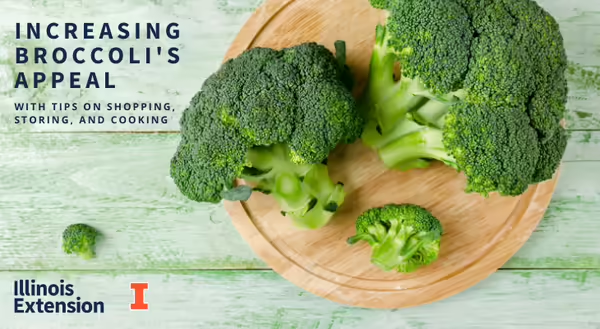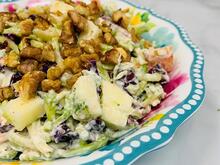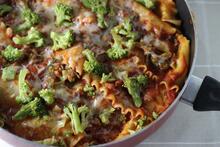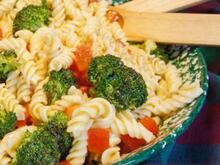
Along with green peas, broccoli might be tied as the most unpopular veggie with kids. I was an exception. As a kid and adult, broccoli is one of my favorite veggies - cooked at least. Raw broccoli doesn't appeal to me. Even a dietitian has food preferences, so this is a reminder that how food is presented changes its flavor, texture, and acceptability to kids and adults alike. If broccoli hasn't been a favorite veggie, try out some of the different recipes in this post. You might find one you enjoy.
Nutritionally, 1 cup of broccoli florets contains around 20 calories, 4g carbohydrates, 2g fiber, and is a source of vitamins and minerals including vitamin C, folate, calcium, and potassium. Like many non-starchy veggies, broccoli does not have a significant amount of fat, protein, or sodium.
- Buy:
- Fresh: When buying fresh, look for firm broccoli in a deep green color. Soft and yellowing broccoli can mean the broccoli is old.
- Packaged: Your store's produce section may have broccoli slaw and pre-cut broccoli. Examine the "use-by" or "sell-by" date on the package to check if the product might need to be used soon.
- Frozen: When buying frozen broccoli, check that you are buying the product you want. Frozen broccoli is available plain or with sauce, as well as with mix of florets and stems or florets only.
- Price: Fresh broccoli average $1.92 per pound and frozen averages $1.82 per pound, according to the USDA Fruit and Vegetable Prices.
- Store: Store fresh broccoli unwashed in the refrigerator for around a week. I like to precut broccoli and store unwashed in food-safe covered containers.
- Prepare: Wash fresh broccoli before eating or cooking. Cut into desired size pieces for your recipe. To help reduce food waste, remember that broccoli stems are edible. Try them in slaw, soups, and stir-fries.
- Preserve: The National Center for Home Food Preservation has directions on freezing broccoli at home. This is a great way to prepare a large broccoli crop from a garden or when broccoli goes on sale in stores.
- Eat: Broccoli can be served cooked and raw and adds a pop of green color in recipes! Try a few below!
Crunchy Broccoli Slaw | Print recipe
using broccoli slaw mix
Weeknight Skillet Lasagna | Print recipe
using frozen broccoli
Broccoli and Chive Stuffed Peppers | Print recipe
Dill Pasta Salad | Print recipe
References:
-
University of Maine Cooperative Extension, Bulletin #4177, Vegetables and Fruits for Health: Broccoli and Cauliflower, 2008.
-
US Department of Agriculture, Agriculture Research Service, National Nutrient Database for Standard Reference
Post originally published in 2017; content updated in 2021.
Healthy Eats and Repeat
How much difference is there between canned and frozen foods? How should you cook venison? When is the best time to buy avocados? Get answers to these questions as well as other tips, tutorials and recipes for common kitchen foods and items with University of Illinois Extension Nutrition & Wellness Educator Caitlin Mellendorf.
Caitlin Mellendorf is an Illinois Extension Nutrition and Wellness Educator serving DeWitt, Macon and Piatt Counties in Central Illinois. She is a Registered Dietitian and her work focuses on helping community members gain the knowledge, skills and tools to live healthier, more nutritious lifestyles. This includes providing programs and answering questions about heart health, diabetes, food safety, food preservation, grocery shopping and cooking. You can reach Caitlin by email at chuth2@illinois.edu or call 217.877.6042. Check out her posts for seasonal recipes and an exploration of common kitchen foods.



